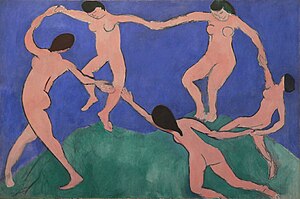
Back اللوحة الغربية من القرن العشرين Arabic Schilderkunst van de 20e eeuw Dutch 20ਵੀਂ ਸਦੀ ਦੀ ਪੱਛਮੀ ਚਿੱਤਰਕਾਰੀ Punjabi

20th-century Western painting begins with the heritage of late-19th-century painters Vincent van Gogh, Paul Cézanne, Paul Gauguin, Georges Seurat, Henri de Toulouse-Lautrec, and others who were essential for the development of modern art. At the beginning of the 20th century, Henri Matisse and several other young artists including the pre-cubist Georges Braque, André Derain, Raoul Dufy and Maurice de Vlaminck, revolutionized the Paris art world with "wild", multi-colored, expressive landscapes and figure paintings that the critics called Fauvism. Matisse's second version of The Dance signified a key point in his career and in the development of modern painting.[1] It reflected Matisse's incipient fascination with primitive art: the intense warm color of the figures against the cool blue-green background and the rhythmical succession of the dancing nudes convey the feelings of emotional liberation and hedonism.
Initially influenced by Toulouse-Lautrec, Gauguin, and other late-19th-century innovators, Pablo Picasso made his first cubist paintings based on Cézanne's idea that all depiction of nature can be reduced to three solids: cube, sphere, and cone. With the painting Les Demoiselles d'Avignon (1907; see gallery) Picasso created a new and radical picture depicting a raw and primitive brothel scene with five prostitutes, violently painted women, reminiscent of African tribal masks and his own new proto-Cubist inventions. Analytic cubism, exemplified by Violin and Candlestick, Paris, was jointly developed by Pablo Picasso and Georges Braque from about 1908 through 1912. Analytic cubism was followed by Synthetic cubism, characterized by the introduction of different textures, surfaces, collage elements, papier collé and a large variety of merged subject matter.[2][3]
Crystal Cubism was a distilled form of Cubism consistent with a shift between 1915 and 1916 towards a strong emphasis on flat surface activity and large overlapping geometric planes, practised by Braque, Picasso, Jean Metzinger, Albert Gleizes, Juan Gris, Diego Rivera, Henri Laurens, Jacques Lipchitz, Alexander Archipenko, Fernand Léger, and several other artists into the 1920s.[4]
During the years between 1910 and the end of World War I and after the heyday of cubism, several movements emerged in Paris. Giorgio de Chirico moved to Paris in July 1911, where he joined his brother Andrea (the poet and painter known as Alberto Savinio). Through his brother he met Pierre Laprade, a member of the jury at the Salon d'Automne, where he exhibited three of his dreamlike works: Enigma of the Oracle, Enigma of an Afternoon and Self-Portrait. During 1913 he exhibited his work at the Salon des Indépendants and Salon d’Automne, where his work was noticed by Pablo Picasso, Guillaume Apollinaire, and others. His compelling and mysterious paintings are considered instrumental to the early beginnings of Surrealism. Song of Love (1914) is one of the most famous works by de Chirico and is an early example of the surrealist style, though it was painted ten years before the movement was "founded" by André Breton in 1924.[5]
In the first two decades of the 20th century, as Cubism evolved, several other important movements emerged; Futurism (Giacomo Balla), Abstract art (Wassily Kandinsky), Der Blaue Reiter (Kandinsky and Franz Marc), Bauhaus (Kandinsky and Paul Klee), Orphism, (Robert Delaunay and František Kupka), Synchromism (Morgan Russell and Stanton Macdonald-Wright), De Stijl (Theo van Doesburg and Piet Mondrian), Suprematism (Kazimir Malevich), Constructivism (Vladimir Tatlin), Dadaism (Marcel Duchamp, Picabia and Jean Arp), and Surrealism (Giorgio de Chirico, André Breton, Joan Miró, René Magritte, Salvador Dalí and Max Ernst). Modern painting influenced all the visual arts, from Modernist architecture and design, to avant-garde film, theatre and modern dance, and became an experimental laboratory for the expression of visual experience, from photography and concrete poetry to advertising art and fashion. Van Gogh's paintings exerted great influence upon 20th-century Expressionism, as can be seen in the work of the Fauves, Die Brücke (a group led by German painter Ernst Kirchner), and the Expressionism of Edvard Munch, Egon Schiele, Marc Chagall, Amedeo Modigliani, Chaïm Soutine, and others.
- ^ Clement, Russell T. (1996). Four French Symbolists. Westport, Connecticut: Greenwood Press. p. 114. ISBN 978-0-31329-752-6.
- ^ "Cubism: The Leonard A. Lauder Collection". Metropolitan Museum of Art. October 10, 2014. Retrieved June 30, 2019.
- ^ Cooper, Douglas (1970). The Cubist Epoch. London, UK: Phaidon Press. pp. 11–221, 232. ISBN 0-87587-041-4.
- ^ Green, Christopher (1987). Cubism and its Enemies, Modern Movements and Reaction in French Art, 1916–1928. New Haven & London: Yale University Press. pp. 13–47, 215. ISBN 978-0-30003-468-4.
- ^ "Giorgio de Chirico. The Song of Love. Paris, June-July 1914". The Museum of Modern Art. Retrieved June 30, 2019.
© MMXXIII Rich X Search. We shall prevail. All rights reserved. Rich X Search